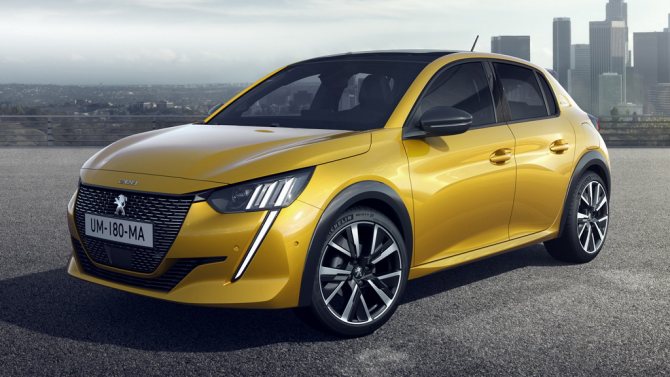
Peugeot 208 - many reasons to be happy
Modern automotive society is very demanding on cars. The average buyer has an image of his car in his head, which should be: original, beautiful, solid, economical, reliable and, moreover, cheap. In a flood of such proposals, poor Kowalski gets lost, because nothing really catches the eye and nothing surprises. The panacea for this, breaking stereotypes, is the new Peugeot 208.
When Peugeot launched the 1983 in 205, no one expected how successful this small city car would be. Fifteen years of production and more than five million vehicles sold have brought benefits to Peugeot both financially and in terms of image. Only a madman would not want to continue such a great cause, so in the following years the 206 and 207 models were created. However, they were periodically enlarged and made similar to other brothers in the Peugeot city car lineup - and although popular with customers, they were not so revolutionary, like the 205. And finally, 2012 arrived, and with it another version of Peugeot with two fronts - 208.
In order to produce a car that would appeal to a wide range of buyers who are known to have different requirements, Peugeot needed not only to refresh the concept, but also to redefine from the ground up what these buyers actually expect from such a car. . What do they expect? Most of the time it's (almost) impossible. The car should be extraordinary, but not too flashy, small on the outside and big on the inside, economical and dynamic at the same time, cheap but well equipped - you can change it endlessly. These requirements may seem meaningless, but thanks to such a high bar, today's cars are separated from their predecessors by an abyss in both technical and equipment. How will the model 208 surprise us?
First, the driver's seat. How is it different? Peugeot engineers have tested what a potential driver can see without taking their eyes off the road. It turns out that if we talk about on-board instruments, then this is not much, because our viewing angle narrows vertically to about 20 degrees. How can I fix this? For example, you can use head-up displays or, like in Peugeot, revolutionize the dashboard by making the steering wheel smaller and positioning the clock so that it can be seen above the steering wheel rim. Simple, because it does not require additional costs and ingenious, because the steering wheel is small and pleasant to use. True, getting used to this solution takes some time, but personally I am not against such a system, although I must admit that I did not manage to set the steering wheel so that it did not close the indicators at least a little.
Another break from stereotypes is an innovative approach to the location of the touch screen that controls the functions of the radio, navigation, speakerphone or music player. The screen is pushed out to the side of the passenger compartment, so that it is within reach and in the field of view of the driver, all this so that its operation does not distract the driver too much from driving. And while working with the system may seem complicated at first, a few minutes spent getting to know it is enough to understand how it works.
Continuing the theme of the cabin, it should be mentioned that the same wheelbase as the 207 model, and shortening the length of the body by 7 cm does not reduce the amount of space for passengers - quite the contrary. The use of thinner front seatbacks and a redesigned interior design have resulted in 5cm more knee room for rear passengers compared to the 207. The 208's luggage compartment is also larger, with a capacity of 311 liters compared to its height. rear shelf (285 dm3 according to the VDA standard), and with the rear seats folded in one simple movement, even 1152 liters (1076 dm3 according to the VDA standard).
Buyers interested in the 208 will be able to choose between two body styles - 3-door and 5-door. The dynamically sculpted body side looks completely different in each of these versions. Scuff marks on the 5-door doors extend from the taillights to the front of the bodywork, creating a consistent look. The profile of the 3-door version is definitely more sculpted. The heavy embossing gives it an aggressive look, and overall, the back panel, which should be shaped like the one used on the iconic Peugeot 205, looks very neat.
How does the 208 behave on the road? For the test, we received a 3d version with a 1,6 liter e-HDI engine and 115 hp. and a manual 6-speed gearbox. The drive is highly agile, and the car is equipped with it cheerfully, because in less than 10 seconds it accelerates to a speed of 100 km / h. Inside, thanks to good sound insulation, it is really quiet - only a few sounds of wheels struggling with uneven asphalt are heard. The driving position is very comfortable thanks to the well profiled seats and the two-way adjustable steering wheel. The suspension is elastic - the car does not sway during fast maneuvers, but at the same time it does not collapse on larger irregularities. We really enjoyed navigating the tight Masurian curves - unbalancing the Peugeot 208 is as difficult as stuffing a large cup of coffee into the holder on the center console.
Prices for the 208 model start from PLN 39900 for the Access 3d version with the 1,0 VTi 68KM engine. The cheapest option is with a 1,4 HDi diesel engine producing 68 hp. costs 52200 zlotys. Peugeot has high hopes for the 208, aiming to sell 265 this year. units, and in the next 550 thousand becomes the leader in the segment. Will it be a repeat success? Let's see.

